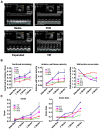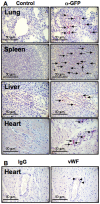Stem cell therapy with overexpressed VEGF and PDGF genes improves cardiac function in a rat infarct model
- PMID: 19809493
- PMCID: PMC2752797
- DOI: 10.1371/journal.pone.0007325
Stem cell therapy with overexpressed VEGF and PDGF genes improves cardiac function in a rat infarct model
Abstract
Background: Therapeutic potential was evaluated in a rat model of myocardial infarction using nanofiber-expanded human cord blood derived hematopoietic stem cells (CD133+/CD34+) genetically modified with VEGF plus PDGF genes (VIP).
Methods and findings: Myocardial function was monitored every two weeks up to six weeks after therapy. Echocardiography revealed time dependent improvement of left ventricular function evaluated by M-mode, fractional shortening, anterior wall tissue velocity, wall motion score index, strain and strain rate in animals treated with VEGF plus PDGF overexpressed stem cells (VIP) compared to nanofiber expanded cells (Exp), freshly isolated cells (FCB) or media control (Media). Improvement observed was as follows: VIP>Exp> FCB>media. Similar trend was noticed in the exercise capacity of rats on a treadmill. These findings correlated with significantly increased neovascularization in ischemic tissue and markedly reduced infarct area in animals in the VIP group. Stem cells in addition to their usual homing sites such as lung, spleen, bone marrow and liver, also migrated to sites of myocardial ischemia. The improvement of cardiac function correlated with expression of heart tissue connexin 43, a gap junctional protein, and heart tissue angiogenesis related protein molecules like VEGF, pNOS3, NOS2 and GSK3. There was no evidence of upregulation in the molecules of oncogenic potential in genetically modified or other stem cell therapy groups.
Conclusion: Regenerative therapy using nanofiber-expanded hematopoietic stem cells with overexpression of VEGF and PDGF has a favorable impact on the improvement of rat myocardial function accompanied by upregulation of tissue connexin 43 and pro-angiogenic molecules after infarction.
Conflict of interest statement
Figures







References
-
- Gluckman EG, Roch VV, Chastang C. Use of Cord Blood Cells for Banking and Transplant. Oncologist. 1997;2:340–343. - PubMed
-
- Tse W, Bunting KD, Laughlin MJ. New insights into cord blood stem cell transplantation. Curr Opin Hematol. 2008;15:279–284. - PubMed
-
- Segers VF, Lee RT. Stem-cell therapy for cardiac disease. Nature. 2008;451:937–942. - PubMed
-
- Daley GQ, Scadden DT. Prospects for stem cell-based therapy. Cell. 2008;132:544–548. - PubMed
Publication types
MeSH terms
Substances
Grants and funding
LinkOut - more resources
Full Text Sources
Other Literature Sources
Medical
Research Materials
Miscellaneous

